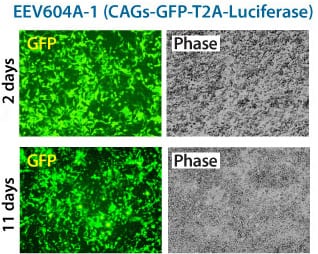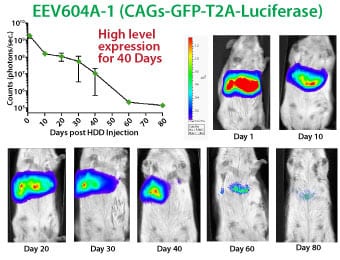CAGs-MCS Enhanced Episomal Vector (EEV)
- High levels of expression
- Easy to clone formats
- No special plasmid production
- Nonviral, non-integrating technology
- Constitutive and inducible vector formats
Products
| Catalog Number | Description | Size | Price | Quantity | Add to Cart | |||
|---|---|---|---|---|---|---|---|---|
| EEV600A-1 | Constitutive (CAGs promoter) EEV cloning and expression vector | 10 µg | $659 |
|
||||
Overview
Overview
An easy-to-produce non-integrating option for gene expression
With virtually no limits on insert size (unlike AAV vectors) Enhanced Episomal Vectors (EEVs) are an excellent choice for non-integrating, non-viral gene expression. Because they replicate in synchrony with the host cell, they are stably inherited and can be used for long-lasting expression—up to several months both in vitro and in vivo—without modifying the host genome. Use SBI’s CAGs-MCS EEV Vector (Cat.# EEV600A-1) for constitutive expression in most cell types including primary cells and stem cells with the strong CAG promoter.
 SBI’s EEV System, which is an enhanced version of the Epstein-Barr Nuclear Antigen-1 (oriP-EBNA1) system, offers:
SBI’s EEV System, which is an enhanced version of the Epstein-Barr Nuclear Antigen-1 (oriP-EBNA1) system, offers:
- High levels of expression
- Easy to clone formats
- No special plasmid production
- Nonviral, non-integrating technology
- Constitutive and inducible vector formats
Please note the following Licensing Restrictions for the EEV system:
For Academic and Non-Profit Institutions:
Researchers at academic and non-profit institutes are granted full access to purchasing the EEV cloning vectors and reporters. Full sequence information is provided upon proof of purchase of EEV vectors. Please contact SBI’s technical support at tech@systembio.com for sequence information.
For Commercial Customers:
For-profit and commercial customers can purchase the pre-made EEV reporters (EEV604A-1, EEV605A-1); however, due to licensing restrictions, cloning EEV vectors (e.g. EEV600A-1 and EEV610A-1) are not available for purchase directly. Instead, these are available through SBI’s custom EEV cloning and production services. SBI then provides the commercial customer with the desired amount of ready-to-use EEV custom construct DNA.
References
How It Works
Supporting Data
Supporting Data
Sustained, non-integrating gene expression in vitro and in vivo with EEV
Figure 1. A constitutive EEV reporter based on CAGs-MCS delivers similar amounts of GFP expression in vitro after two days and eleven days. SBI’s EEV reporter plasmid CAGs-GFP-T2A-Luciferase (Cat.# EEV604A-2), contains a GFP-T2A-Luciferase cassette cloned into the CAGs-MCS EEV Vector (Cat.# EEV601A-1). This plasmid was transfected into HEK293T cells (0.5 µg of CAGs-GFP-Luciferase in a 24-well plate) and GFP transgene expression imaged. There is little change in GFP signal between two- and eleven-days post-transfection.
Figure 2. A constitutive EEV reporter based on CAGs-MCS delivers high levels of expression in mice over forty days. 8 µg of the constitutive CAGs-GFP-T2A-Luciferase construct (Cat.# EEV604A-2) was introduced into test mice through hydrodynamic tail vein injection (HDD), a procedure which leads to high plasmid DNA transfection of the livers of mice in vivo. The test mice (n=3) were imaged for body luminescence in the liver area post-HDD from Day 1 up until Day 80. The results show that robust EEV-expressed luciferase expression is readily detectable at very high levels through day 40.
FAQs
Documentation
Citations
Related Products
Products
| Catalog Number | Description | Size | Price | Quantity | Add to Cart | |||
|---|---|---|---|---|---|---|---|---|
| EEV600A-1 | Constitutive (CAGs promoter) EEV cloning and expression vector | 10 µg | $659 |
|
||||
Overview
Overview
An easy-to-produce non-integrating option for gene expression
With virtually no limits on insert size (unlike AAV vectors) Enhanced Episomal Vectors (EEVs) are an excellent choice for non-integrating, non-viral gene expression. Because they replicate in synchrony with the host cell, they are stably inherited and can be used for long-lasting expression—up to several months both in vitro and in vivo—without modifying the host genome. Use SBI’s CAGs-MCS EEV Vector (Cat.# EEV600A-1) for constitutive expression in most cell types including primary cells and stem cells with the strong CAG promoter.
 SBI’s EEV System, which is an enhanced version of the Epstein-Barr Nuclear Antigen-1 (oriP-EBNA1) system, offers:
SBI’s EEV System, which is an enhanced version of the Epstein-Barr Nuclear Antigen-1 (oriP-EBNA1) system, offers:
- High levels of expression
- Easy to clone formats
- No special plasmid production
- Nonviral, non-integrating technology
- Constitutive and inducible vector formats
Please note the following Licensing Restrictions for the EEV system:
For Academic and Non-Profit Institutions:
Researchers at academic and non-profit institutes are granted full access to purchasing the EEV cloning vectors and reporters. Full sequence information is provided upon proof of purchase of EEV vectors. Please contact SBI’s technical support at tech@systembio.com for sequence information.
For Commercial Customers:
For-profit and commercial customers can purchase the pre-made EEV reporters (EEV604A-1, EEV605A-1); however, due to licensing restrictions, cloning EEV vectors (e.g. EEV600A-1 and EEV610A-1) are not available for purchase directly. Instead, these are available through SBI’s custom EEV cloning and production services. SBI then provides the commercial customer with the desired amount of ready-to-use EEV custom construct DNA.
References
How It Works
Supporting Data
Supporting Data
Sustained, non-integrating gene expression in vitro and in vivo with EEV
Figure 1. A constitutive EEV reporter based on CAGs-MCS delivers similar amounts of GFP expression in vitro after two days and eleven days. SBI’s EEV reporter plasmid CAGs-GFP-T2A-Luciferase (Cat.# EEV604A-2), contains a GFP-T2A-Luciferase cassette cloned into the CAGs-MCS EEV Vector (Cat.# EEV601A-1). This plasmid was transfected into HEK293T cells (0.5 µg of CAGs-GFP-Luciferase in a 24-well plate) and GFP transgene expression imaged. There is little change in GFP signal between two- and eleven-days post-transfection.
Figure 2. A constitutive EEV reporter based on CAGs-MCS delivers high levels of expression in mice over forty days. 8 µg of the constitutive CAGs-GFP-T2A-Luciferase construct (Cat.# EEV604A-2) was introduced into test mice through hydrodynamic tail vein injection (HDD), a procedure which leads to high plasmid DNA transfection of the livers of mice in vivo. The test mice (n=3) were imaged for body luminescence in the liver area post-HDD from Day 1 up until Day 80. The results show that robust EEV-expressed luciferase expression is readily detectable at very high levels through day 40.



